Or search by topic
Number and algebra
Geometry and measure
Probability and statistics
Working mathematically
Advanced mathematics
For younger learners
Difference of Two Squares



- Problem
- Getting Started
- Student Solutions
- Teachers' Resources
Darius from Victoria College in the Channel Islands and Maisy from Long Field Academy in England noticed that, when using the 3 times table, the difference is a multiple of 3. Maisy wrote:
3 (3 times table):
22 = 4
42 = 16
16 $-$ 4 = 12
12 is in the 3 times table because 4 $\times$ 3 = 12
Sanika from India and Sarvitha from The Ellen Wilkinson School for Girls, James from High Storrs School and Alex from Long Field Academy, all in the UK, noticed that this always gives a multiple of 12. This is Sarvitha's work:
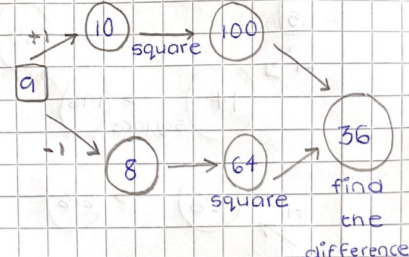
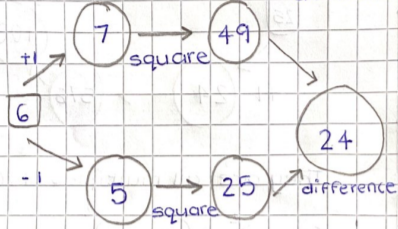
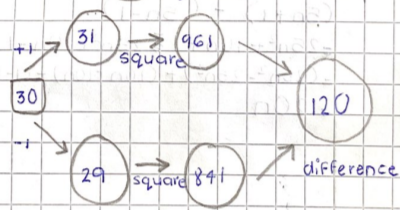 They are all multiples of 12
They are all multiples of 12
Sarvitha proved this result by writing $3n$ for any multiple of 3:
Elissa from The Ellen Wilkinson School for Girls, James, Darius, Sanika and Alex all noticed and proved something slightly different. This is Alex's work:
The pattern is that your answer will always be 4 $\times$ your initial number.
I can prove this because:
In the 3 times table: $x$ = the number you times by $3.$
e.g. If $x = 1,$ chosen number [in the 3 times table] is $3,$
If $x = 2,$ chosen number is $6$
The numbers in the sequence are
$(3x -1), 3x, (3x+ 1)$
$(3x + 1) (3x + 1) -((3x-1) (3x-1)) = 9x^2 + 6x + 1 - (9x^2- 6x +1) = 12x$
Which is 4$\times$3$x$, so 4$\times$ the number in the 3 times table.
For numbers in the 5 times table, Darius noticed and proved that the difference between the squares is always a multiple of 5:
Let $5n$ be a multiple of $5, n \in \mathbb{N}, n \gt1$
$\therefore$ difference of squares of numbers on either side is equal to: $$\begin{align} (5n+1)^2 &- (5n-1)^2\\
= 25n^2+10n+1 &-(25n^2-10n+1)\\
= 20n\end{align}$$
$\dfrac{20n}{4} = 5n \therefore 20n$ is a multiple of $5$
Alexis from Long Field Academy, James and Sarvitha noticed that they are in fact multiples of 20. In fact, you can see this from Darius' proof.
Once again, Alex proved that the difference is always 4 times the original multiple of 5. The proof is actually the same as Darius' proof that the difference is $20n,$ because $20n = 4\times 5n$ which is 4 times the original multiple of 5.
What about different times tables? Maisy from Long Field Academy wrote:
Whatever times table the first number you picked comes from, the number you
end up with is in it. For example:
12 (6 times table):
11 squared = 121
13 squared = 169
169 $-$ 121 = 48
48 is in the 6 times table because 8 $\times$ 6 = 48.
Darius and Sanika proved it. This is Darius' proof:
Let $\alpha n$ be a multiple of $\alpha$ (this is the same step as before, just with the $\alpha$ times table, rather than the $3$ or $5$ times table).
$\therefore$ difference of squares of numbers either side is: $$\begin{align} (\alpha n+1)^2 &- (\alpha n-1)^2\\
= \alpha^2n^2+10n+1 &-(\alpha^2n^2-10n+1)\\
= 4\alpha n\end{align}$$ Dividing by $\alpha$, which is the times table:
$\dfrac{4\alpha n}{\alpha} = 4n \therefore 4\alpha n$ is a multiple of $\alpha $
Louis from the UK tried numbers in the 7 times table:

Holly from Long Field Academy noticed something else familiar:
If you pick a number and multiply it by 4 this is equal to the difference between the squares of the numbers either side of your chosen number.
e.g. If I chose the number 18 and multiply this by 4 you will get 72.
The squares of 17 and 19 are 289 and 361; the difference between 361 and 289 is 72.
James, Alex and Elissa all proved this. Alex's proof is the same as Darius' proof, but noting that $4\alpha n = 4\times\alpha n$ is four times the original number. James ignored the times table, which resulted in simpler notation:
Let $m =$ any multiple of a number. The differences of the squares of the numbers one digit above and one digit below this number can be represented, once again using algebra, as $$(m+1)^2 - (m-1)^2 = (m+2m+1) - (m-2m+1)$$ which equals $$m - -2m = 4m$$
Elissa used slightly different algebra, and included a diagrammatic proof as well as an algebraic proof:
$\begin{align}&(a+2)^2 - a^2\\
=&(a+2)(a+2) - a^2\\
=&a^2 + 4a + 4 - a^2\\
=&4a+4\hspace{5mm} = 4(a+1)\end{align}$
Diagrammatically:
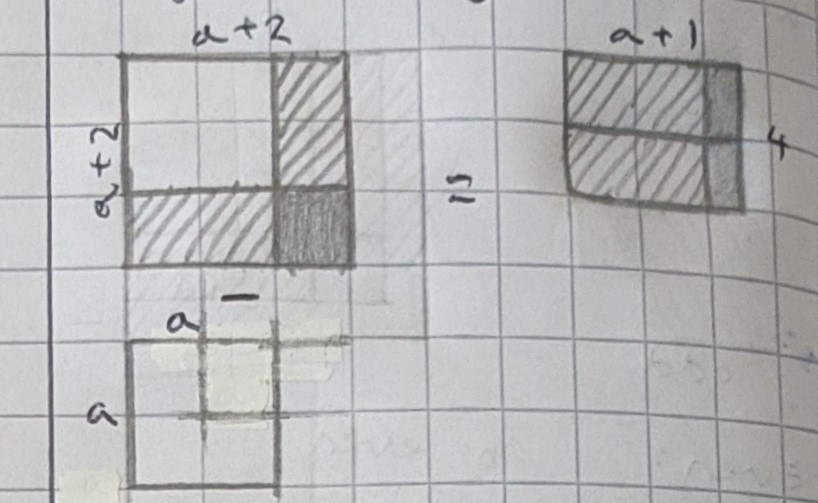
What about other gaps? Jonty from Long Field Academy, Sanika and Alex tried using gaps of 2 instead of 1. This is Alex's work:
$(x-2), x, (x+2)$
$\begin{align}(x+2) (x+2) &- ((x-2) (x-2))\\
=x^2 +2x+2x+4&-(x^2-2x-2x+4)\\
=8x \end{align}$
Jonty also tried using gaps of 3:
$(n+3)^2 - (n-3)^2 = n\times12$
I do believe there [are similar relationships for other numbers] as it works for all possibilities I've tried.
Amy from Long Field Academy and Daruis both proved some facts about any gap. This is Amy's work:
The formula to get the answer for this question is $4xn$, where $x$ is the number that you start with and $n=$ the amount that you count either side of that number.
The way that I got to this formula was by doing this equation:
$((x+n)\times(x+n)) - ((x-n)\times(x-n))$
This can be expanded out to:
$(x^2 + xn + xn + n^2) - (x ^2 - xn -xn -n^2)$
Which can be simplified to:
$2xn - -2xn$
When there are two subtraction signs next to each other, they would become an addition sign and so, you would get the answer $4xn.$
Darius, once again, noted that this is a multiple of $x$.
It is also possible to prove this result by factorising:
Suppose the two numbers are $a$ and $b$, where the number half-way between $a$ and $b$ is $n$, with $a = n+g$ and $b=n-g$ for some gap $g.$
$a^2 - b^2$ can be factorised as $(a+b)(a-b).$
$a+b$ is double the average of $a$ and $b,$ $\dfrac{a+b}{2},$ which is $n.$ So $a+b = 2n.$
$a-b$ is double the gap, because it is the distance from $b$ to $n$ plus the distance from $n$ to $a.$ So $a-b=2g.$
$\therefore a^2 - b^2 = (a+b)(a-b) = 2n\times2g = 4ng.$
Freya from Long Field Academy made a different observation by subtracting squares of consecutive numbers, rather than squares of numbers two apart. Click to see Freya's work.
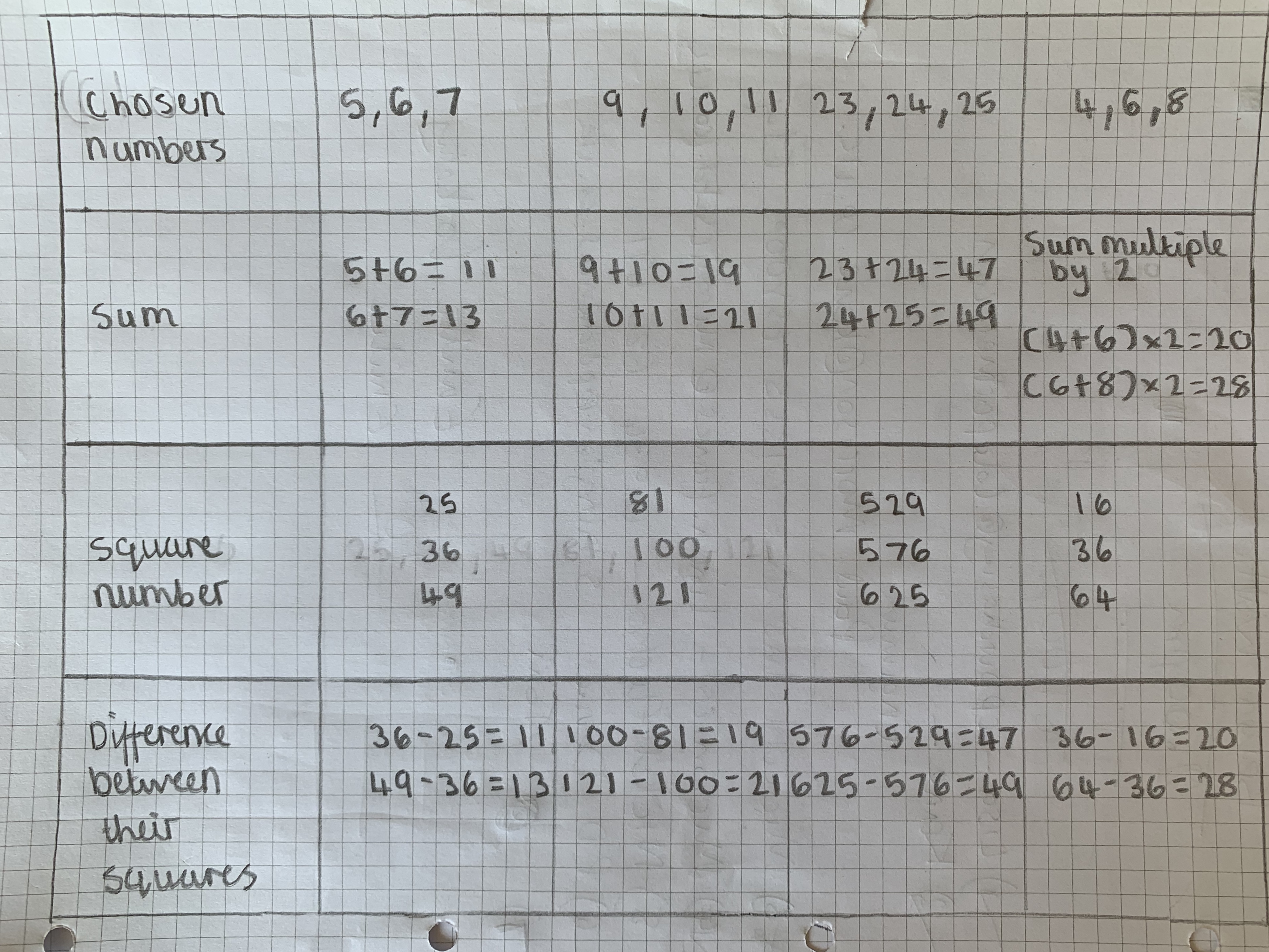
Victor from KCLMS in the UK sent in a brave proof that the difference between two squares is always a multiple of three, regardless of whether they are near multiples of three. Here is Victor's work:
Claim: $a^2-b^2=3P$
(that is, taking the squares of any two integers $a$ and $b$, the difference will be $3P$ which is a multiple of three)
Proof:
$3K=a +10b$
($K$ is a name that Victor gives this number because it will be useful later in the proof)
$\Rightarrow 3K-10b=a$
$\begin{split}a^2-b^2&= (3K-10b)^2 -b^2\\
&=9K^2-60bK+100b^2 - b^2\\
&=9K^2-60kb+99b^2\\
&=3(3K^2 -20Kb +33b^2)\end{split}\\
\Rightarrow P= 3K^2 -20Kb +33b^2$
That looks very convincing, but we have seen from the examples above that it isn't always true! For example, $6^2-4^2 = 36-16 = 20,$ which is not a multiple of three. Can you spot the trick in Victor's proof? Click to see an explanation.
At the end of the proof, we end up with $P = 3K^2 - 20Kb + 11b^2.$ If $K$ is an integer then this will be an integer. However, if $K$ is not an integer, then $P$ might not be an integer either, so $3P$ might not be in the three times table. For example, when $b=4$ and $K=\frac{46}3,$ $P = 3K^2 - 20Kb + 11b^2 = \frac{20}3,$ and so $3P=20$ which is not in the three times table.
You may also like
DOTS Division
Take any pair of two digit numbers x=ab and y=cd where, without loss of generality, ab > cd . Form two 4 digit numbers r=abcd and s=cdab and calculate: {r^2 - s^2} /{x^2 - y^2}.
Sixational
The nth term of a sequence is given by the formula n^3 + 11n. Find the first four terms of the sequence given by this formula and the first term of the sequence which is bigger than one million. Prove that all terms of the sequence are divisible by 6.

